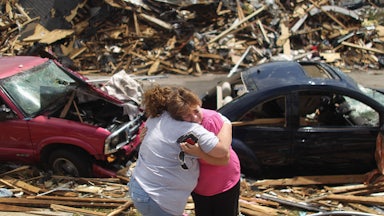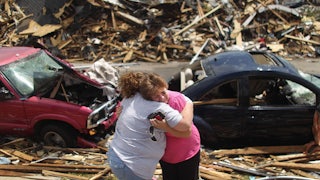Easter in South Africa traditionally provides locals with their last chance for a sun-soaked autumnal holiday. Tens of thousands of Johannesburgers head to Durban, or “Durbs,” to lie on beaches, take their kids to the aquarium, and eat sinus-clearing crab curries. This year, though, a mere three days before the Good Friday tourist crush, a subtropical depression named Issa dumped 16 inches of rain—half what Durban typically gets in a year—on the city in less than 24 hours.
Six thousand houses were damaged. At least 450 people died. President Ramaphosa described Durban’s worst floods in 60 years as “a disaster of catastrophic proportions.”
By coincidence, a friend and I had a research trip scheduled for the week after the floods. We drove past jumbled shipping containers lying strewn alongside the N2 highway. We turned our car around to avoid suburban streets still submerged in shoulder-high mud. We hiked along beaches carpeted with plastic patio chairs, shopping bags, cracked Tupperware containers, and chip packets. Soda bottles and traffic cones bobbed in the nearby waves. Much of the city, including our Airbnb, had no running water. While we were there, South Africa’s state electricity supplier also announced rolling blackouts, citing damage to hydroelectric dams.
Impoverished communities shared information via WhatsApp groups about government water-truck deliveries. Community organizations cleaned up the busiest beaches. In the middle-class suburb of the Bluff, we bought water in well-stocked supermarkets, ate takeout rotis to circumvent the need for electric stoves and dishwashing, and bathed in our host’s swimming pool. In much the same way, during the 2018 Cape Town water crisis, I learned to take 60-second showers and flush the toilet with leftover soapy water.
As such experiences become more common in the Anthropocene, how will we as humans navigate them? The devastation in Durban has illuminated, above all, a troubling lesson about the life-or-death importance of infrastructure in a warming world. And it serves as a stark warning to countries like both South Africa and the United States—which struggled mightily to pass an infrastructure bill last year—about what happens when governments fail to think long term.
Climate breakdown can be deceptive. The Southwest undergoes its worst megadrought in 2000 years, but the BART keeps running even as the San Francisco sky turns brown from wildfire smoke. Houston drowns in Hurricane Harvey’s deluge, yet three years later, life is back to normal. On the flip side, climate breakdown can, of course, also look hazily apocalyptic, the metaphorical asteroid destroying the Earth in Don’t Look Up, or nightmares about Arctic methane fueling a runaway greenhouse effect.
Yet as the 2022 Intergovernmental Panel on Climate Change report “Impacts, Adaptation, and Vulnerability” makes clear, it is likely that the devastation of global warming will fall somewhere between the unimaginably destructive and the fundamentally manageable. Where it falls on that spectrum depends largely on us. Unless we both reduce emissions and adapt to increasingly severe weather, more species will become extinct, the world will become more unequal, and infrastructure will fail much more rapidly.
The U.S. Infrastructure Investment and Jobs Act (known as the “Bipartisan Infrastructure Bill”), South Africa’s own National Climate Change Adaption Strategy, and the Durban Climate Plan of 2019 all attempt, with varying degrees of ambition, to avert the worst of our possible futures.
The Bipartisan Infrastructure Bill does so in three broad ways. First, the legislation allocates hundreds of billions of dollars for much-needed repairs, maintenance, and reconstruction. Second, it mandates changes to make America’s infrastructure more resilient, from protecting power lines against wildfires to safeguarding the electric grid against hackers. Finally, it aims to reduce the inequality flagged by the IPCC as both a cause and a symptom of environmental crisis—for example, by providing vouchers for low-income families to afford broadband.
Commentators have agreed that while the bill still falls significantly short of the investments engineers say are needed to bring U.S. infrastructure up to scratch, it nevertheless represents a “good start.” But much will depend on the specific implementation, as many have pointed out. It’s in the application that most climate adaptation succeeds or fails. In the past, Durban has in fact been seen as a model of a developing-world, climate-adaptive city. Yet as a recent op-ed in South Africa’s Mail and Guardian argued, it is hard to see Durban’s recent desolation as evidence of anything other than a horrifying lack of preparedness.
How did reality fail rhetoric? And how might other countries minimize similar failures?
In Durban, Larry Oellermann directs the Oceanographic Research Institute, one of the key organizations monitoring the health of Africa’s East Coast oceans. The ORI focuses on a range of issues foregrounded by the recent floods, including agricultural runoff, sewage, plastic pollution, and silting of estuaries. I asked him how to make sense of the catastrophe in Durban.
“Actually,” he said, “I am asking myself the same question. On the one hand, I know that this will do real damage. On the other, I also know that both humans and nature will bounce back.” The floods and plastic on their own, he said, would not change the fact that, with its extensive protected areas, KwaZulu-Natal has some of the most vibrant marine biodiversity in the world. Nor did he anticipate that the catastrophe, as a single incident, would radically reduce the quality of life of the city’s surviving inhabitants.
“The threats to both our seas and society are much more cumulative,” he said. “In the oceans, we can measure changes in water or salinity, along with the migration of species as they adjust to environmental change. These alterations are occurring steadily, but they don’t happen in a single week.” Durban’s experience, he said, is a warning. “What we are experiencing now in Durban is a microcosm of where the whole world is headed, unless we change.”
He sketched out what you might call a blueprint of climate maladaptation or failure, which I have expanded here, using additional examples.
A country—South Africa, obviously, but also to some degree the U.S. or any other that suffers from shortsighted decision-making—fails to maintain its infrastructure. Roads, bridges, power stations, and water treatment plants decay at the same time as storms worsen. Water distribution pipes sprout thousands of wasteful leaks in the middle of megadroughts, leading to crises like the one that almost caused Cape Town to turn off its water faucets.
Then a global pandemic hits, one likely connected to the same deforestation that fuels global warming. In South Africa, preventive lockdowns cause poverty, job losses, and declines in tax revenues, resulting in further service delivery degeneration. Climate adaptation plans get shelved because governments no longer have the money to pay for them.
Pandemic stress sharpens, among other things, political polarization. In the U.S., grocery store workers attempting to enforce mask mandates get attacked by customers, and protesters occupy the Capitol to stop the certification of an election.
In South Africa, corrupt former President Jacob Zuma goes to prison, and his political heartland around Durban erupts in violence, with malls burned, highways damaged, and power stations impaired.
Now infrastructure is further compromised—public and private finances even more strained. Repairs get delayed once again.
When the deluge comes, months later, vandalized highway pillars cave in first. The muddy water that fills streams, rivers, and culverts more easily sweeps away buildings recently damaged in political riots—for example, a shopping mall whose foundations sustained fire damage after organized arson.
Long-delayed flood-mitigation infrastructure, from drainage channels to shoreline restoration and marshland, aren’t in place, so the waters sweep farther and stay longer than ever before, drowning hundreds and displacing thousands—for months. In addition, failures of municipal rubbish collection have contributed to widespread littering. So whole mountain ranges of plastic also now float down rivers into the sea.
The 2022 IPCC report is clear: With the requisite political will, humans can move off fossil fuels and keep climate change below 1.5 degrees Celsius (2.7 degrees Fahrenheit). The report also emphasizes adaptation. One key strategy is conservation. In a press release to accompany the report, IPCC Working Group II Co-Chair Hans-Otto Pörtner said, “By restoring degraded ecosystems and effectively and equitably conserving 30 to 50 per cent of Earth’s land, freshwater, and ocean habitats, society can benefit from nature’s capacity to absorb and store carbon.”
Other well-known adaptation strategies include green buildings, flood-control channels, sustainable transport systems, crop diversification, and the breeding of drought-resistant varieties of crucial crops.
Oellermann echoes this assessment, saying, “Everything is essentially reparable. The natural systems are rejuvenating, the way they are supposed to. We just need to figure out how to give ecosystems a chance to do their job.” In KwaZulu-Natal, he imagines that this might involve restoring estuaries and wetlands to create buffers between ocean and land.
The IPCC advocates broad and politically diverse discussions about climate adaptation, in part to avoid unintended consequences, such as when Germany inadvertently increased its carbon emissions by closing down nuclear plants.
Arguably, bipartisan conversations made some aspects of the U.S. Infrastructure Bill more effective, with Republicans pushing, for example, for improvements in rural broadband. But most Republicans still opposed the infrastructure bill, apparently mostly out of reluctance to hand Biden a victory. The U.S. is in a stronger position to handle climate change than South Africa. No equivalent to the severe fiscal cutbacks that stymied South Africa’s adaptation plans have yet occurred in the U.S.
Still, hyperpartisanship has conspicuously hamstrung America’s ability to accomplish even the most modest social goals in recent years, as evidenced by everything from some of the world’s worst Covid-19 numbers all the way to the failure to pass bipartisan emissions-reduction legislation. So Americans will need to hold our government to account to implement the Infrastructure Bill, pass further such laws as needed, and overcome general partisan gridlock.
We will also need to keep building strong community connections. As Durbanites learned the hard way this year, social coherence is itself an important form of climate resilience, and being able to rely on your neighbors of all political persuasions will be a necessity rather than a luxury in the decades ahead.










